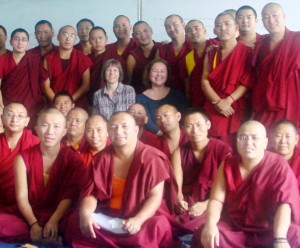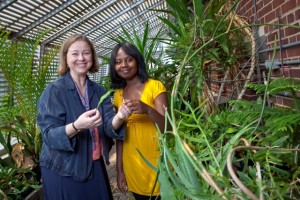A few months ago, Anna Edlund opened her email account to not one but two pleasant surprises. First, her audience with the Dalai Lama was scheduled for June. Second, she had been awarded a Fulbright grant.

Anna Edlund (right center) with her class in India
Edlund is among four biology professors spending two weeks in India teaching Western science and biology to the Dalai Lama’s monks. The professors are divided into two teams, each pair teaching a class of 50 monks and several nuns for six hours a day through an interpreter. Edlund and her teaching partner are focusing on disease, the immune system, and epidemiology.
Read a profile of Edlund
Edlund’s visit is organized by the Emory-Tibet Science Initiative, a partnership between Emory University and the Dalai Lama. After the biology professors depart, small teams of neuroscientists and physicists will each arrive to teach the same students.
Edlund’s whirlwind summer doesn’t stop in India. From there, she’ll travel to Sweden, funded by a Fulbright grant, to study the art of a founding father of her field of pollen biology. The laboratory notebooks of scientist Gunnar Erdtman contain hundreds of drawings of pollen grains. Spending about three months in Stockholm, Edlund will work at the Swedish Museum of Natural History, where she’ll examine Erdtman’s papers and scientific illustrations and conduct interviews about the late scientist.
Edlund is passionate about the art of scientific illustration. In her lab classes at Lafayette, she requires her students to keep special journals in which they make meticulous illustrations of what they observe. She also has invited a professional scientific illustrator to instruct her biology students in observation and basic drawing.

Anna Edlund, assistant professor of biology with and Belinda Sibanda '11 in the greenhouse of Kunkel Hall
Erdtman, Edlund explains, stylized his drawings and devised a diagrammatic form called the palynogram to represent the most essential identifying features of a pollen grain. Little is known about the scientist beyond the few personal details shared by friends through several obituaries following his death in 1973.
In addition to studying his art and papers, Edlund plans to interview scientists and family members who knew Erdtman to create a fuller picture of how art training and sensibility influenced his science.
“If I were drawing a comic of Gunnar Erdtman, I might place him on the sidewalk, working as a caricaturist,” she says. “The pollen grains would be waiting in line, as he caught the nature of each one in only a few deft strokes.”
Edlund will prepare an illustrated article on Erdtman’s palynograms, his contributions to pollen science, and the historical and personal context in which he worked. She hopes to share her findings in a public lecture at the museum and to organize a historical session at the International Palynological Congress.
In her Fulbright application, Edlund described Erdtman as a polymath, skilled in both art and science, and wrote that through her study of him and her travels, she hoped to become more of a polymath herself.
With her interest in art and science, Edlund feels at home at Lafayette, where the value of interdisciplinary coursework is emphasized.
“My charge as a professor at a small college is much more than lecturing,” she says. “I am to model for my students an open-minded, curious, interdisciplinary approach, and the more I can draw connections, think up rich metaphors, and share anecdotes, the more my students will care about and remember their lessons in biology.”

